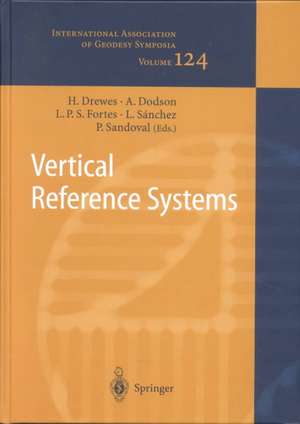Vertical Reference Systems: IAG Symposium Cartagena, Colombia, February 20–23, 2001: International Association of Geodesy Symposia, cartea 124
Editat de Hermann Drewes, Alan H. Dodson, Luiz P.S. Fortes, Laura Sanchez, Pedro Sandovalen Limba Engleză Hardback – 6 aug 2002
| Toate formatele și edițiile | Preț | Express |
|---|---|---|
| Paperback (1) | 1225.61 lei 6-8 săpt. | |
| Springer Berlin, Heidelberg – 9 dec 2010 | 1225.61 lei 6-8 săpt. | |
| Hardback (1) | 1074.62 lei 38-44 zile | |
| Springer Berlin, Heidelberg – 6 aug 2002 | 1074.62 lei 38-44 zile |
Din seria International Association of Geodesy Symposia
- 15%
 Preț: 660.49 lei
Preț: 660.49 lei - 18%
 Preț: 956.81 lei
Preț: 956.81 lei - 18%
 Preț: 958.38 lei
Preț: 958.38 lei -
 Preț: 440.22 lei
Preț: 440.22 lei -
 Preț: 430.59 lei
Preț: 430.59 lei -
 Preț: 435.38 lei
Preț: 435.38 lei -
 Preț: 405.28 lei
Preț: 405.28 lei - 15%
 Preț: 662.62 lei
Preț: 662.62 lei - 15%
 Preț: 641.38 lei
Preț: 641.38 lei - 15%
 Preț: 642.03 lei
Preț: 642.03 lei - 15%
 Preț: 640.55 lei
Preț: 640.55 lei - 15%
 Preț: 666.89 lei
Preț: 666.89 lei - 18%
 Preț: 975.29 lei
Preț: 975.29 lei - 15%
 Preț: 661.14 lei
Preț: 661.14 lei - 15%
 Preț: 655.45 lei
Preț: 655.45 lei - 15%
 Preț: 644.18 lei
Preț: 644.18 lei - 15%
 Preț: 666.24 lei
Preț: 666.24 lei - 15%
 Preț: 679.00 lei
Preț: 679.00 lei - 15%
 Preț: 662.30 lei
Preț: 662.30 lei - 20%
 Preț: 579.46 lei
Preț: 579.46 lei - 20%
 Preț: 566.39 lei
Preț: 566.39 lei - 24%
 Preț: 1640.04 lei
Preț: 1640.04 lei - 18%
 Preț: 1228.62 lei
Preț: 1228.62 lei - 18%
 Preț: 957.62 lei
Preț: 957.62 lei - 20%
 Preț: 571.23 lei
Preț: 571.23 lei - 18%
 Preț: 1221.69 lei
Preț: 1221.69 lei - 18%
 Preț: 1234.94 lei
Preț: 1234.94 lei - 24%
 Preț: 1633.19 lei
Preț: 1633.19 lei - 24%
 Preț: 1199.25 lei
Preț: 1199.25 lei - 24%
 Preț: 1080.15 lei
Preț: 1080.15 lei - 24%
 Preț: 1549.43 lei
Preț: 1549.43 lei - 18%
 Preț: 1232.89 lei
Preț: 1232.89 lei - 18%
 Preț: 1280.86 lei
Preț: 1280.86 lei - 24%
 Preț: 1069.44 lei
Preț: 1069.44 lei - 18%
 Preț: 1238.56 lei
Preț: 1238.56 lei - 24%
 Preț: 1142.96 lei
Preț: 1142.96 lei
Preț: 1074.62 lei
Preț vechi: 1413.97 lei
-24% Nou
Puncte Express: 1612
Preț estimativ în valută:
205.66€ • 213.91$ • 169.78£
205.66€ • 213.91$ • 169.78£
Carte tipărită la comandă
Livrare economică 10-16 aprilie
Preluare comenzi: 021 569.72.76
Specificații
ISBN-13: 9783540430117
ISBN-10: 3540430113
Pagini: 368
Ilustrații: X, 355 p.
Dimensiuni: 193 x 270 x 25 mm
Ediția:2002
Editura: Springer Berlin, Heidelberg
Colecția Springer
Seria International Association of Geodesy Symposia
Locul publicării:Berlin, Heidelberg, Germany
ISBN-10: 3540430113
Pagini: 368
Ilustrații: X, 355 p.
Dimensiuni: 193 x 270 x 25 mm
Ediția:2002
Editura: Springer Berlin, Heidelberg
Colecția Springer
Seria International Association of Geodesy Symposia
Locul publicării:Berlin, Heidelberg, Germany
Public țintă
ResearchCuprins
The cooperation between IAG and PAIGH.- Velocity estimates of IGS RNAAC SIRGAS stations.- The vertical reference system in the Argentine Republic.- Improvements in the ellipsoidal heights of the Argentine reference frame.- Brazilian first order levelling network.- The vertical geodetic network in Chile.- Approach to the new vertical reference system for Colombia.- Vertical control networks in Indonesia.- Current status of vertical control network in Peninsular Malaysia and plans for adjustment.- Vertical geodetic network of Mexico.- The new height system in Switzerland.- Subsidence of the permanent GPS station Bogotá.- Time series analysis of the daily solutions of the AGRS.NL reference stations.- Vertical motions from geodetic and geological data: a critical discussion of the results.- Central European vertical and kinematic systems.- Advances in the calculation of a height transformation model in Buenos Aires Province.- Estimation of station heights with GPS.- Contribution of individual space techniques to the realization of vertical reference systems.- Analysis of time series of GPS height estimates with regard to atmospheric pressure loading.- The impact of antenna radomes on height estimates in regional GPS networks.- Influence of tropospheric zenith delays obtained by GPS and VLBI on station heights.- A study on the effects of data accuracy and datum inconsistencies on relative GPS levelling.- Employing the strict kinematic model for the maintenance of a height reference frame based on conventional levellings.- Minimising the error budget in the third precise levelling of Sweden.- The influence of gravity variations on leveled heights.- Motorised levelling — the ultimate tool for production of classic national height networks.- New results in the determinationof the geoid model in Argentina.- Data collecting and processing for quasi-geoid determination in Brazil.- Improving the quasigeoid model in Colombia.- Isostatic anomaly maps for Colombia.- Project to refine the geoidal solution in the Mexican area.- The vertical datum and local geoid models in Uruguay.- One approach to determine the geoid local trend at Montevideo area.- Current status of geoid calculation in Venezuela.- Geoidal undulations from GPS measurements in Venezuela.- Geoid study in Tierra del Fuego.- Preliminary geoid model for Tierra del Fuego.- Using a “GPS/MSL geoid” to test geoid models in the UK.- Online and postprocessed GPS-heighting based on the concept of a digital height reference surface (DFHRS).- General scheme for the computation of regional geoid undulations using spherical wavelets.- Predicting free-air gravity anomaly using artificial neural network.- Local geoid models — practical considerations.- The sea surface topography and its impact to global height system definition.- Correlation between multi-mission altimeter time series and tide gauge registrations in the Caribbean sea.- The EVAMARIA project: Identification and verification of sea level anomalies in the North Atlantic.- Vertical crustal movements of tide gauges sites around the North Atlantic Ocean.- Caribbean sea level variability from TOPEX/Poseidon altimetry.- Monitoring tide gauges benchmarks in Argentina by GPS.- Mean sea level and sea surface variability of Indonesian waters from TOPEX/Poseidon.- Using GPS to separate crustal movements and sea level changes at tide gauges in the UK.- Towards a globally consistent nautical chart datum definition in France.- The 3-D coastline of the new millenium (managing datums in n-dimension space).- Geoid variations due to mean sealevel variations.- World height system specified by geopotential at tide gauge stations.- Scientific foundations of the SIRGAS vertical reference system.- The vertical reference frame for the Americas — The SIRGAS 2000 GPS campaign.- Preliminary results of SIRGAS 2000 campaign — IBGE analysis center.- Processing of the SIRGAS 2000 GPS network at DGFI.- Associated problems to link South American vertical networks and possible approaches to face them.- Connection of the vertical control networks of Venezuela, Brazil and Colombia.- Attempts to unify the Australian height datum between the Mainland and Tasmania.- Towards the establishment of an Indonesian unified vertical datum.- Determination of a unified height reference system for the computation of a local geoid around the volcanoes Merapi and Merbabu, Java, Indonesia.- The vertical reference system for Europe.- Cartagena Statement on Vertical Reference Systems.
Caracteristici
Complete overview of problems related with height systems










